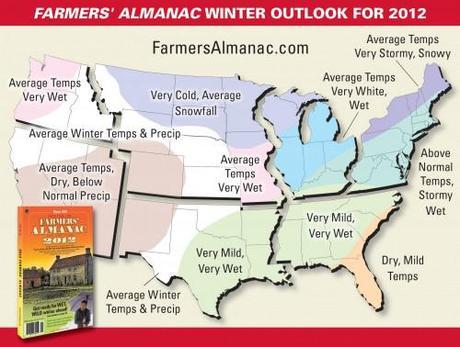Either way, it's who I am. A premature over paranoid preparer.
In light of the recent "freak" October Snow storm here in New Jersey I see no time being better than the present to start preparing for the pending winter.
One reliable source I have found to be pretty accurate with Weather Predictions is The Farmers Almanac. You can visit them by clicking the link.
Here I will show you the photo from their page of an overview of the United States.

Any how, every time that the winter season is coming around, I start to prepare.
For whatever reason it is. My husband is a plowman so when a storm is coming he is called to work, usually long before it starts piling up. Depending on the storms expectations, and accumulations my husband could be gone for several days.
With two children and lack of driving capabilitys I get prepared for the worst.
Here are a few things that I do to prepare, followed by other winter preparedness tips from both Ready.gov and FarmersAlmanac.com
My most valuable preparation is my friend, every snow she packs her bags and heads on over to bunker down with me while we enjoy the winter. Its great to have her, she helps with the house and the kids, and when the roads are cleared she is willing to drive and get whatever we ran out of, or need in the house.
This year will be different because of where I live, without getting into details et me just say that I feel much safer and more secure where I am. My family is surrounded by wonderful people.
My biggest fear of winter storms is a power outage, power outages mean no lights or heat. This is what I prepare for.
I start my preparations by stocking upon groceries, the basics of Milk, Bread, Eggs and Cheese are a Must have. Unlike Summer storms I do not worry about whether or not it needs to be refrigerated because most everything can be placed in a bag in the snow to keep cold.
Blankets, when there is News of a storm approaching I gather all the household blankets, and place them into my "hunker down" room. (this room is usually my kids room, because it is easier to keep the kids entertained in there than anywhere else)
Cell phones charged, I make sure that cells are all completely charged, in the event of a power outage they can and will come in VERY handy. When the power goes out make the necessary calls to family members, power company etc. then power down the device to conserve its battery for an
Emergency, it's also a good idea to have car chargers for all electronic devices.
Which brings me to the next preparation. Gasoline, Making sure that cars are fueled up prior to a storm. While driving during and early after a storm is dangerous the gas can be used for other purposes. If you lose heat in your home you can go into your car and run the heat to stay warm, listen to the local radio for emergency broadcasting and charging your devices.
Most all of my other preparations are listed on Ready.Gov such as the following copied from their website.
Step 1: Get A Kit
Get an Emergency Supply Kit which includes items like non-perishable food, water, a battery-powered or hand-crank radio, extra flashlights and batteries.
Thoroughly check and update your family's Emergency Supply Kit before winter approaches and add the following supplies in preparation for winter weather:
Rock salt or more environmentally safe products to melt ice on walkways. Visit the Environmental Protection Agency for a complete list of recommended products.
Sand to improve traction
Snow shovels and other snow removal equipment.
Also include adequate clothing and blankets to keep you warm.
Step 2: Make A Plan
Prepare Your Family
Make a Family Emergency Plan. Your family may not be together when disaster strikes, so it is important to know how you will contact one another, how you will get back together and what you will do in case of an emergency.
Plan places where your family will meet, both within and outside of your immediate neighborhood.
It may be easier to make a long-distance phone call than to call across town, so an out-of-town contact may be in a better position to communicate among separated family members.
You may also want to inquire about emergency plans at places where your family spends time: work, daycare and school. If no plans exist, consider volunteering to help create one.
Take a Community Emergency Response Team (CERT) class from your local Citizen Corps chapter. Keep your training current.
Step 3: Be Informed
Prepare Your Home
Make sure your home is well insulated and that you have weather stripping around your doors and windowsills to keep the warm air inside.
Insulate pipes with insulation or newspapers and plastic and allow faucets to drip a little during cold weather to avoid freezing.
Learn how to shut off water valves (in case a pipe bursts).
Keep fire extinguishers on hand, and make sure everyone in your house knows how to use them. House fires pose an additional risk as more people turn to alternate heating sources without taking the necessary safety precautions.
Know ahead of time what you should do to help elderly or disabled friends, neighbors or employees.
Hire a contractor to check the structural stability of the roof to sustain unusually heavy weight from the accumulation of snow - or water, if drains on flat roofs do not work.
If you have a car, fill the gas tank in case you have to leave. In addition, check or have a mechanic check the following items on your car:
Antifreeze levels - ensure they are sufficient to avoid freezing.
Battery and ignition system - should be in top condition and battery terminals should be clean.
Brakes - check for wear and fluid levels.
Exhaust system - check for leaks and crimped pipes and repair or replace as necessary. Carbon monoxide is deadly and usually gives no warning.
Fuel and air filters - replace and keep water out of the system by using additives and maintaining a full tank of gas.
Heater and defroster - ensure they work properly.
Lights and flashing hazard lights - check for serviceability.
Oil - check for level and weight. Heavier oils congeal more at low temperatures and do not lubricat as well.
Thermostat - ensure it works properly.
Tires - make sure the tires have adequate tread. All-weather radials are usually adequate for most winter conditions. However, some jurisdictions require that to drive on their roads, vehicles must be equipped with chains or snow tires with studs.
Windshield wiper equipment - repair any problems and maintain proper washer fluid level.
Familiarize yourself with the terms that are used to identify winter weather
Freezing Rain creates a coating of ice on roads and walkways.
Sleet is rain that turns to ice pellets before reaching the ground. Sleet also causes roads to freeze and become slippery.
Winter Weather Advisory means cold, ice and snow are expected.
Winter Storm Watch means severe weather such as heavy snow or ice is possible in the next day or two.
Winter Storm Warning means severe winter conditions have begun or will begin very soon.
Blizzard Warning means heavy snow and strong winds will produce a blinding snow, near zero visibility, deep drifts and life-threatening wind chill.
Frost/Freeze Warning means below freezing temperatures are expected.
When a Winter Storm WATCH is issued
Listen to NOAA Weather Radio, local radio, and television stations, or cable television such as The Weather Channel for further updates.
Be alert to changing weather conditions.
Avoid unnecessary travel
When a Winter Storm WARNING is issued
Stay indoors during the storm.
If you must go outside, several layers of lightweight clothing will keep you warmer than a single heavy coat. Gloves (or mittens) and a hat will prevent loss of body heat. Cover your mouth to protect your lungs.
Walk carefully on snowy, icy, walkways.
If the pipes freeze, remove any insulation or layers of newspapers and wrap pipes in rags. Completely open all faucets and pour hot water over the pipes, starting where they were most exposed to the cold (or where the cold was most likely to penetrate).
Maintain ventilation when using kerosene heaters to avoid build-up of toxic fumes. Refuel kerosene heaters outside and keep them at least three feet from flammable objects.
Avoid traveling by car in a storm, but if you must...
Carry an Emergency Supply Kit in the trunk.
Keep your car's gas tank full for emergency use and to keep the fuel line from freezing.
Let someone know your destination, your route, and when you expect to arrive. If your car gets stuck along the way, help can be sent along your predetermined route.
Eat regularly and drink ample fluids, but avoid caffeine and alcohol.
Conserve fuel, if necessary, by keeping your residence cooler than normal. Temporarily close off heat to some rooms.
Listen to Local Officials
Learn about the emergency plans that have been established in your area by your state and local government. In any emergency, always listen to the instructions given by local emergency management officials. For further information on how to plan and prepare for winter storms as well as what to do during and after a winter storm, visit: Federal Emergency Management Agency, NOAA Watch, or American Red Cross.
Also stop over to Get Ready for Winter: From Deck to Roof at Farmers Almanac for more tips.
It's always better to be over prepared than not ready enough.
Maybe its the Panic Disorder, Maybe it's not. Either way I will be ready. Will you?

